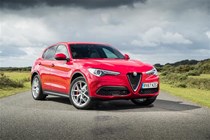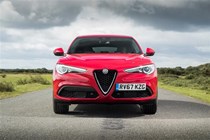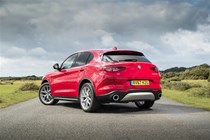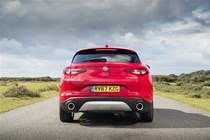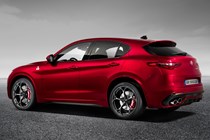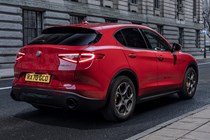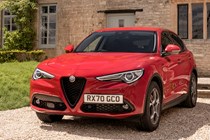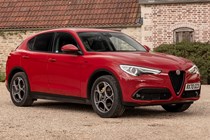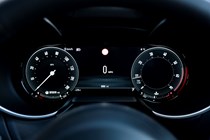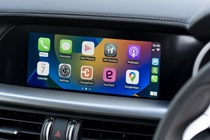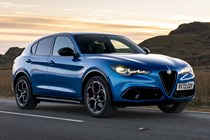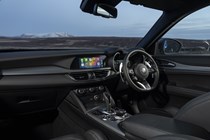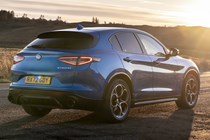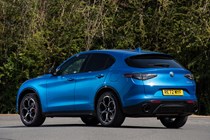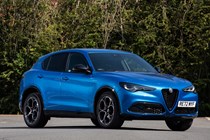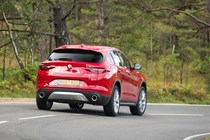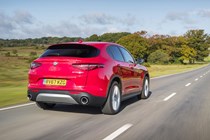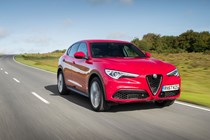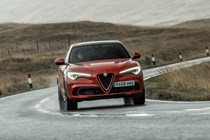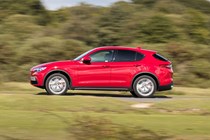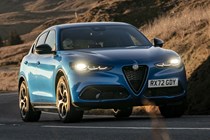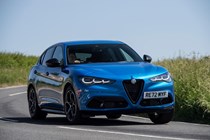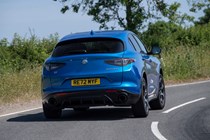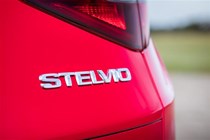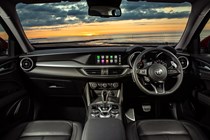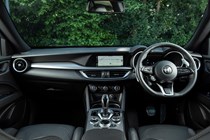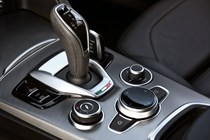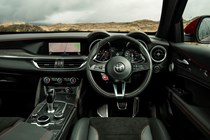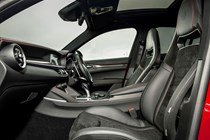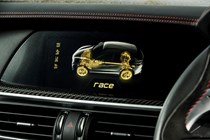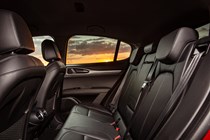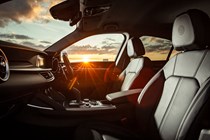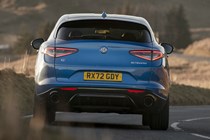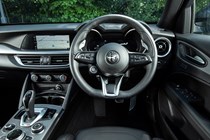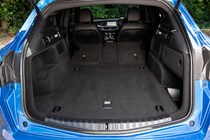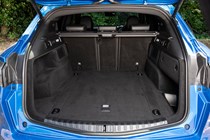
Alfa Romeo Stelvio long-term test
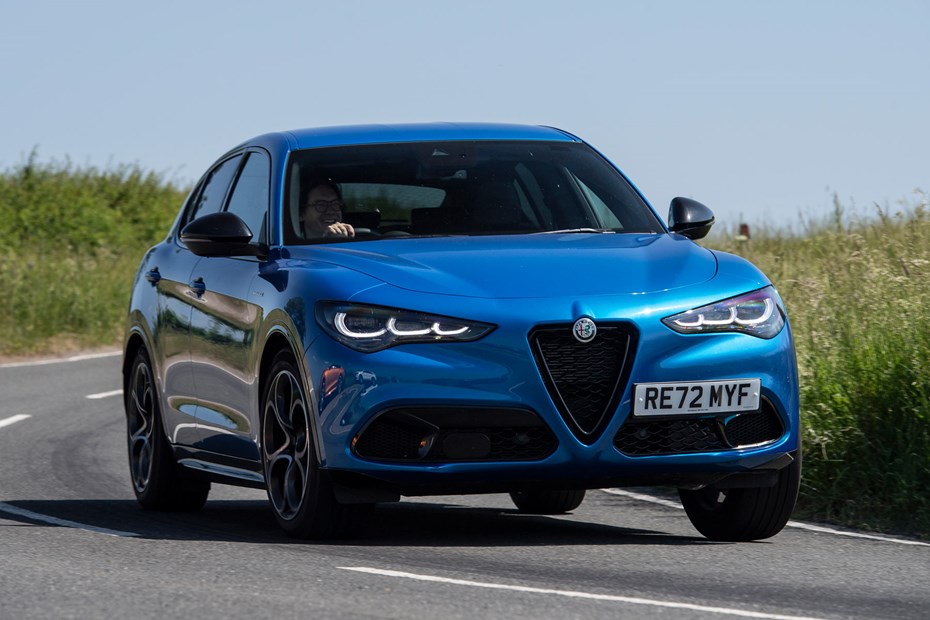
Launched in 2017 and recently updated in 2023, the Stelvio was Alfa Romeo’s first wander into the world of SUVs. Given the brands heritage, we’re expecting an exciting driving experience. So, over the coming months we’ll get right under the skin of our 2.0-litre petrol-powered 280hp Veloce.
Report by: Percy Lawman – Last Updated February 26th 2024
Update 1: Welcome
Update 2: Equipment and Options
Update 3: The Weekly Shop – Practicality in the Boot
Update 4: First Driving Impressions and In the Cabin
Update 5: ‘The Pasty Run’
Update 6: Getting your hands on one and round-up
Update 1: Welcome and Intro
You’ll probably laugh now. My last trip and drive in an Alfa Romeo was in an ‘Alfetta Quadrifoglio Oro’ [Alfetta Gold Four Leaf Clover] back in 1983. I was in Italy for a convention and afterwards, we’d arranged to travel from Torino down to Bari in South Italy. The previous year I’d done the same in a much older rusty 1976 ‘Alfasud’ which was a real [bouncy] eye opener.
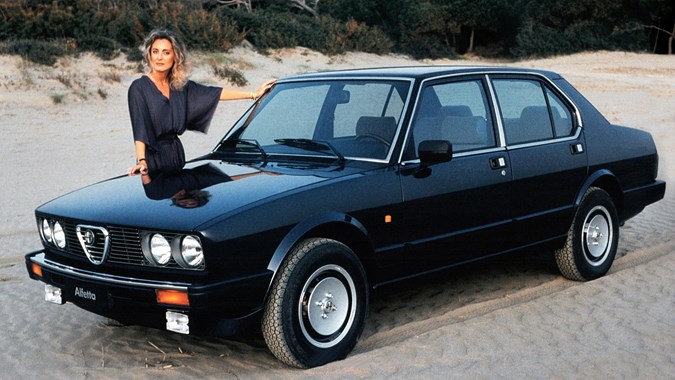
The Alfetta was great and I still remember taking over the wheel around Rimini and San Marino for a few hundred km, making it work hard as we passed the Adriatic coastal towns and watching the fuel gauge drop by the minute; popping into an AGIP station every now and again. It was a real drivers car wanting to be taken to the limit and driven hard. But it was also very elegant – certainly a car to be ‘seen’ in and was somewhat of a status symbol.
There’s something about getting behind the wheel of an ‘Alfa’. You feel like you’ve tripped back to a film set in the 1970’s. You’re young and your right foot has been infused with plutonium. All your senses seem twice as receptive and something has unleashed a sleeping demon from inside you. My Italian friend back then, always referred to his Alfetta as ‘La Diavolo’ [The Devil]. It must be in the DNA.
With the today’s UK roads awash with mundane family inspired SUV’s, I was super excited to have to opportunity to grab the keys of Alfa Romeo’s current 2017- Stelvio which was facelifted in 2023.
I’m in pretty new territory here, but whilst I’ve driven plenty of ‘normal’ SUV’s, the Stelvio certainly looks to be a few rungs up the ladder. Its natural rivals include BMW’s X4, the Jaguar F-Pace and the Porsche Macan to name a few. Saying that, I hope to get up to speed and familiar with the Stelvio pretty quickly.
Our car [RX72 GBV] is the ‘Misano Blue’ 280hp petrol ‘Veloce’ trim level which is mid-range. The others two trims being the entry level ‘Sprint’ and the top-end sporty ‘Competitzione’. All trims are available with either a 280hp petrol or a 210hp diesel power unit. Sporting a top speed of 143mph and a 0-62 of 5.7 seconds via an eight-speed automatic – it’s no slouch.
For real adrenaline junkies, there’s the tarmac-chewing 176mph 512hp Stelvio Quadrifoglio which will see you to Interstellar space pretty rapidly. Saying that; you’ll need a KC-135 Stratotanker in tow to keep you fuelled!
For owners interested in VED data, the CO2 emission for the 280hp petrol engine is 192g/km with a first-year rate of £1565 and an annual VED of £570.00 [Band ‘K’].
Vehicle tax rates are shown here https://www.parkers.co.uk/alfa-romeo/stelvio/suv-2017/car-tax/
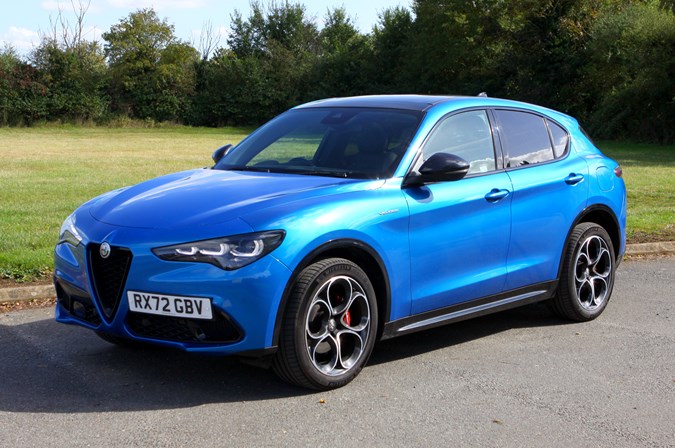
On first visuals, you can immediately see that this is a driver’s car. Out goes all that conservative rubbishy ‘sensible head’ nonsense. This is a car you drive truly from the heart. The wheels are super chunky 20-inch alloys which are a standard fit with 255/45 R20 Michelin Pilot Sport 4 SUV tyres that look like they’d cost a fortune to replace. Well, we checked and you won’t get any change from £1,100 to re-rubber the car with the same brand.
The Stelvio is based around the Alfa ‘Giulia’ saloon platform although the SUV sits around 20cms higher and sports a revised suspension setup. All models feature Alfas ‘Q4’ All Wheel Drive [AWD] system giving all-weather traction capability – making the car a real sporty number in both petrol and diesel guise.
From what we understand, the Alfa Romeo design team wanted to create the Guilia driving experience but in an SUV format. Of course, many SUVs suffer from being rather bouncy and some have sloppy and unpredictable handling especially when worked hard on the road. We’ll see if they’ve succeeded over the coming months as we’re expecting our new Stelvio though to buck that trend with some real engaging driving experiences.
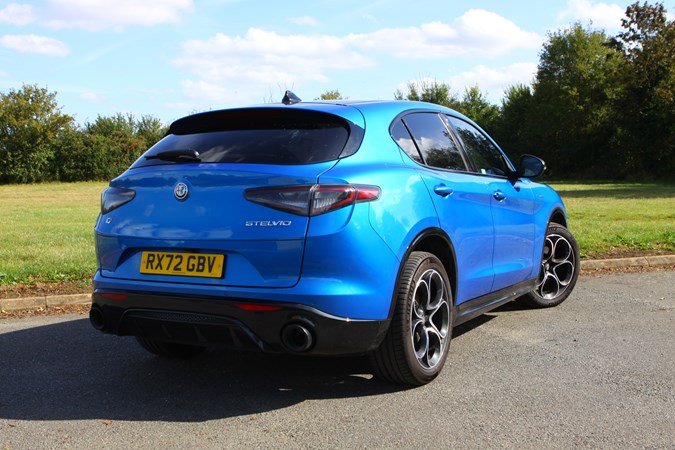
So, stay with us over the late summer and into Autumn/Winter as the Stelvio gets put under the spotlight, living with it on a day-to-day basis.
Update 2: Equipment and Options
As mentioned in the intro, the current Stelvio is available in three different trim levels – Sprint, Veloce and Competizione – although there were a handful of other models such as Lusso, Super, Estrema, Milano Editizione and Speciale which were available from launch.
All present models are available with either a 2.2 litre 210hp turbo diesel engine or a 2.0 280hp 4-cylinder turbo petrol. As standard, there’s’ a very comprehensive list of standard equipment that’s even fitted to the base spec models.
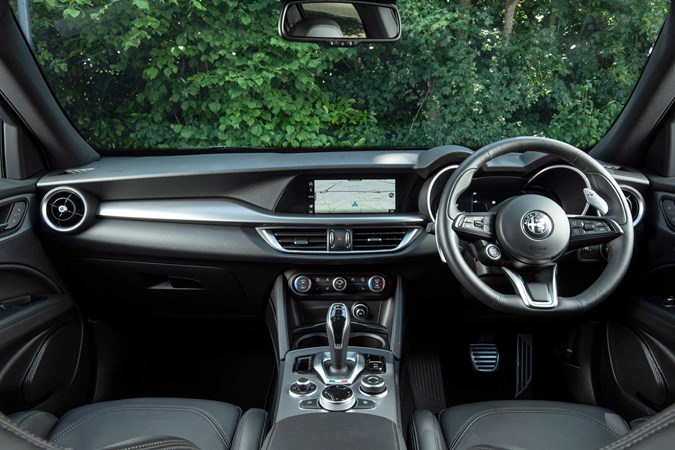
Pricing on the Stelvio range starts at £47,355 for the ‘Sprint’ in 2.2 Turbo Diesel configuration or £47,740 in 2.0 Petrol. Likewise, the ‘Veloce’ starts at £51,855 for the diesel and £54,240 for the petrol. Finally, the top-spec ‘Competizione’ is £56,355 for the diesel and £58,740 for the petrol. All prices are base retail prices without any factory fitted options which of course will be extra.
Our own car has a whole host of factory fitted options including the ‘Driver Assistance Pack’ [£1000] which consists of the following:
- Traffic Jam Assist
- Active Blindspot Assist
- Intelligent Speed Control
- Driver Attention Assist
- Lane Keep Assist
- Highway Assist System [HAS]
- Traffic Sign Recognition [TSR]
Also included are the funky ‘Red Coloured Brake Calipers’ at £450, the ‘Dark Tinted Rear Windows’ at £350, a fully fitted factory sunroof at £1250 and the ‘Premium Interior and Sound Package’ which comprises of a leather dashboard and upper door panels, plus, a 900w ‘Harman Kardon Sound Theatre’ with a 14-way speaker system including subwoofer at £2250.
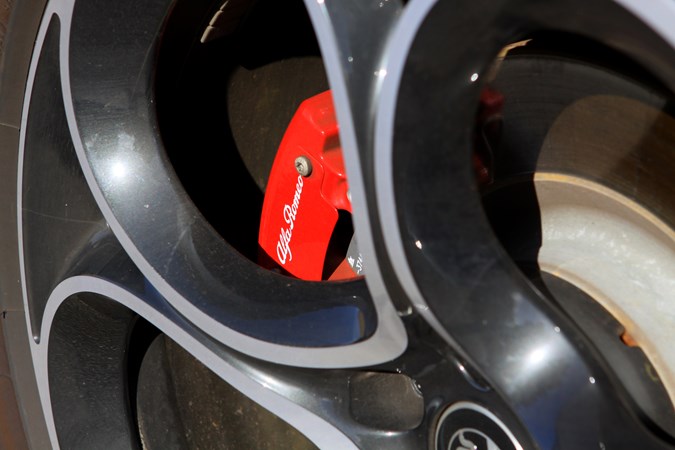
There’s a small handful of other factory options that buyers may want to also consider, these being:
- Metallic paint: £700
- 21-inch 5-hole alloys [20-inch alloys are fitted as standard to the Veloce]: £750
- Power Folding Trailor Tow Hitch: £1250
- Dark Miron Skidplate: £175
See the full specifications here.
Given our own car has the upgraded Harman Kardon 14-Speaker Sound Theatre package, I thought it make good sense to turn up the dBs and get a feel of the upgrade. Harman Kardon have over the years [since the 1950’s] built up a fine reputation for some quality audio packages. In the last 20 years or so, they’ve had an increasing presence in automotive audio. They are now an independent part of Samsung.
Over the years, I’ve owned [and built] quite a hefty array of audio gear. In the early years I was a ‘Bose‘ fan, but moved away from the ‘dark side‘ after betting bored with the over electronic EQ that most Bose kit exhibited. Everything just sounded false. Now a more ‘neutral’ audiophile, I find that equipment from manufactures like Mission, Bowers & Wilkins, KEF and Dali [to name a few] are more my domain.
A look online here shows the 14-speaker 900w ‘Logic 7’ Surround Sound System basics, but there’s little meat on the technical data. The Logic 7 DSP which HK developed for their higher-end A/V receivers basically takes your standard ‘Stereo’ dual channel output and converts it into a [kind of] hybrid 7.1 system. Saying that, it’s been around for over 20 years so isn’t new tech.
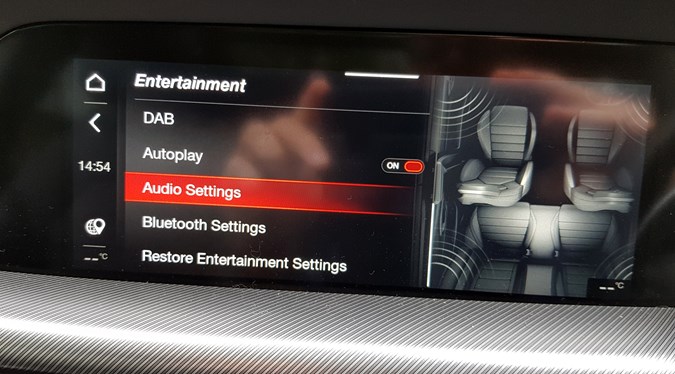
So, what’s the impression?
Well – not that bad actually. Well – once you sort out the default settings on the EQ you can actually make the system shine quite nicely. Soundstage feels reasonable although it’s not super wide and you can also hear there’s plenty of processing going on in order to successfully split ‘Two’ into ‘Seven’ [as such!].
Top ends are crisp and neat without being overly harsh and the lower-end output of the sub-woofer is generally pretty smooth – although I thought the lower-end cut-off frequency felt like it was quite high. In some systems, you hear a deep penetrating bass and whilst the low-end is there, it’s not as heart-thumping and solid as some I’ve heard.

I did feel that there was a little too much mid-range and had to reduce it. Most tracks sounded better with the mids at ‘flat’ or just below. The onboard EQ will only service 3 bands which does seem the ‘norm’ on many in-car audio offerings these days which limits to some extent the amount of user adjustment. Saying that, it’s probably done that way to complement the speaker cross-over frequencies.
Volume wise, the system will max out at 40 although once you start to get to the ‘25’ and above setting, things are pretty loud in the cabin. Move to over 30 and the amount of top end and mids starts to make the experience feel harsh as the bass can’t keep up.
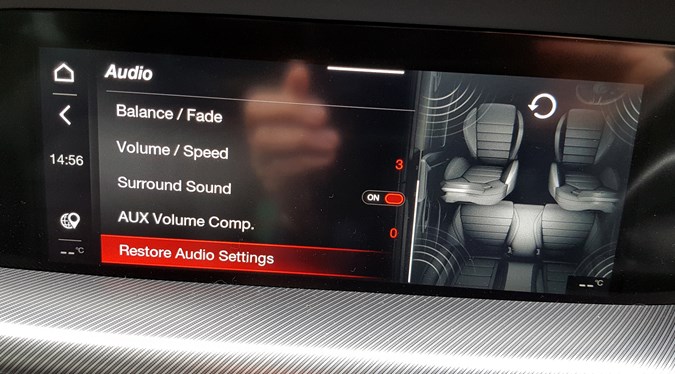
What is slightly interesting is that the speaker system looks to be a four-way setup with the lower end bass split into two ranges. The larger 224mm sub looks to be handling probably everything below about 100Hz, but there’s also 4 x 160mm subs which probably sit in the 4-500Hz range adding some hefty and slightly overpowering mid-lower end. Top end is probably 2kHz and above.
Unfortunately, there’s no info on upper/lower frequency ranges of each speaker unit or their cross-over frequencies but it’s probably a 4-way, 3-section filter pair. Such a crossover might commonly represent a 3-way speaker system along with an additional subwoofer.
We’d be interested to know where the bottom lower frequency response of the largest sub cuts off as we felt there was a lack of real bottom-end. Adding to the experience, there’s also an additional ‘Surround Sound‘ setting which can be turned on/off although there’s no other user selectable controls in that dept.
All-in-all as a factory fitted option, it’s a worthy upgrade at £2250 for any audio aficionado and worth considering the extra outlay but don’t expect it to be in the B&W league.
Update 3: The Weekly Shop – Practicality in the Boot
As always, we’ll always take our new long-term cars to the local supermarket. So, here’s a quick update on what sometimes could seem a rather mundane exercise, but has actually proved invaluable for potential owners. Very frequently we get surprised by the lack of boot space in some cars which on the surface doesn’t seem to be an issue.

For example, a Honda HR-V has a boot size less than a Vauxhall Corsa. On the face of it this looks to be wrong but a weekly shopping trip highlighted this as we failed [badly] to get a weekly shop in for a family of four in the boot, having to then drop the remaining bags in the back seating area.
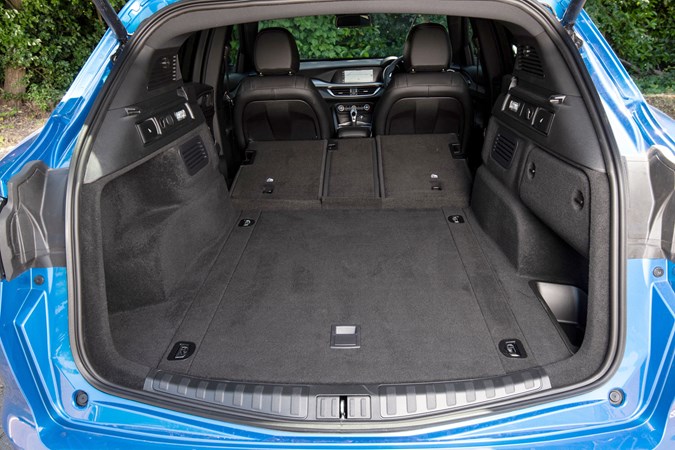
The Stelvio has an official boot area of 525 litres with all seats up and approximately 1600 with the rear seats lowered. The 40/20/40 seat arrangement allows the luggage compartment to be partially or totally extended. This puts it on-par with SUVs such as Skoda’s Karoq at 521.

A trip to Aldi didn’t disappoint with the car swallowing 12 bags of shopping with ease [with the seats up] and with plenty of room to spare. So, it passes the weekly shopping trip with flying colours.
Update 4: First Driving Impressions and In the Cabin
During the first few weeks of ownership, you tend to get a feel of how a car drives. With the Stelvio, this became apparent very quickly that it’s a real driver’s car with a raspy 4-cylinder petrol turbo engine ready to perform. In the corners it felt ultra-stable with none of the wallowing and sagging you get from many an SUV. It actually handles better with less roll than some saloon cars I’ve driven. Steering was very direct and precise and you needed very little input to achieve your objective. The car thrives around fast corners and is well at home out on the open road. It requires a little more encouragement on slower twisty roads but a brisk blip on the throttle will soon get you back in motion again.
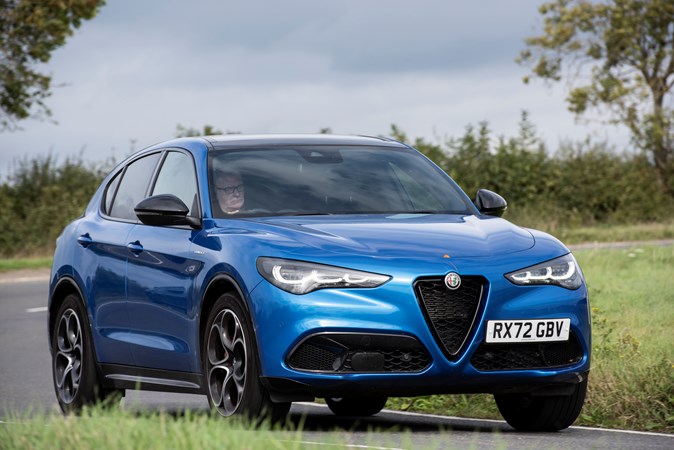
When driving you have the choice of three drive modes, Eco, Normal and Dynamic – however Alfa Romeo badge this as their ‘DNA’ system akin to Dynamic, Normal and Advanced Efficiency aka ‘Eco’.
Most buyers will leave the car in Normal as ‘Eco’ tends to make the car feel a bit lethargic and dead-weight. Pop the selector into Dynamic and all 280 horses are ready for action. Revs are kept higher and the great responsiveness, together with fast/light steering, gets even better. Dynamic is just the ticket for twisty roads when you want some action, or for fast roads that need instant feedback and response from the car. Generally, the ride is on the firm side, but we like it like that as it suits the car well. It’s still pretty well behaved even at low speeds. The last thing you want is a Stelvio with a bout of ‘Bouncy Castle’ syndrome!
We found the 20-inch rims suited the car well and didn’t produce any additional noticeable road-noise which actually isn’t an issue as we felt the car was well insulated. Some have mentioned that the optional ‘21’s could raise the nose by a few dB’s but we found the ‘20’s’ did a great all-round job.
On poorer and minor roads and at lower speeds we found the ride very acceptable.
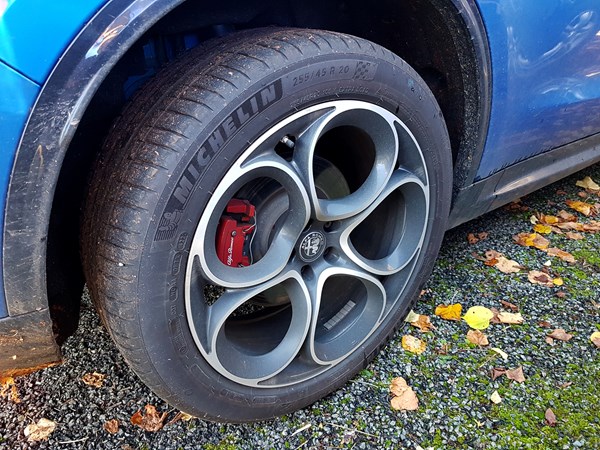
On acceleration we found using the paddle shift was a joy and although the first couple of shifts in the lower gears seemed slightly hesitant, the car would motor through the 8-speed ZF auto gearbox actually feeling pretty quick in the process. 62 mph is reached in a brisk 5.5 seconds that would keep many a hot-hatch at bay. When you think the Stelvio comes in at a chunky 1660kg then there’s quite a substantial amount of weight to haul around. The brakes are well up to the job but you can certainly feel them working hard to bleed off the SUV’s re-entry speed.
The 2.0 petrol engine produces a fair amount of mid-range torque which aids you well out on the open road, although we found our Italian friend became rather thirsty the more you exercise your right foot especially when in ‘D’ mode. Official WLTP figures give the petrol Stelvio a combined fuel consumption figure of 33.2mpg. In the real world we found this figure to be about right, even when we chose the odd ‘brisk’ moment – so all credit for the accurate figures. Our own figures were based on driving nearly 95% of the time in ‘Normal’ mode.
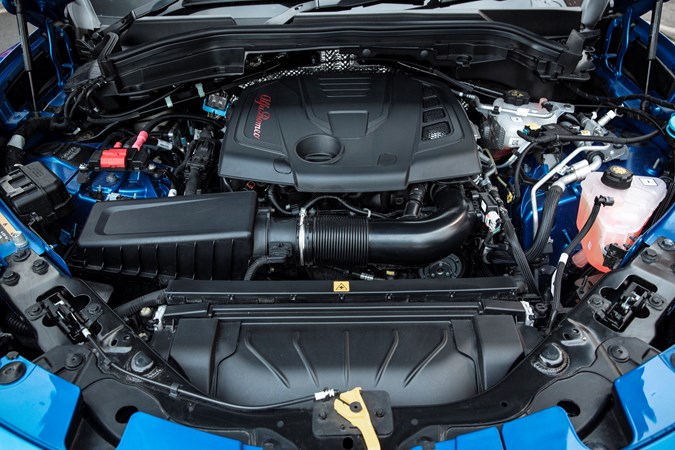
Consumption dropped into the high twenties when the car was pushed and worked hard, but that was to be expected. Saying that, if you choose to cruise around at a more leisurely 60mph or so, then the mid to high ‘thirties’ should be easily achievable. We found the 64-litre tank gave a range of up to around 575 miles with a pretty accurate onboard calculator. I think most Stelvio owners won’t decide to buy the car based on fuel consumption and green credentials, especially those eyeing up the insanely quick 510hp Ferrari influenced Quadrifoglio.
Inside, the 2023 update hasn’t changed much, which is a bit of a shame. The general cabin quality isn’t that bad and I really love the front seats as I think they are extremely comfortable, but in some areas, it doesn’t feel quite as plush or as quite well-screwed-together as BMW’s X3 or X4 for instance. In the rear, the back seats are comfortable [if not outstanding like the fronts] and there’s a reasonable amount of leg room that will accommodate a six-footer with ease.
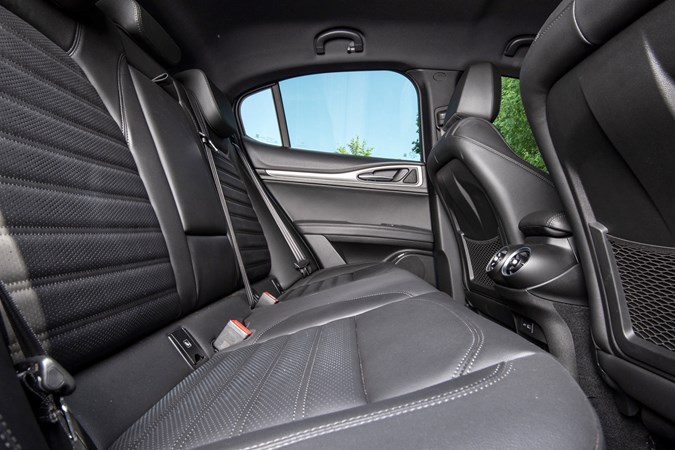
When you decide to park-up in a tight space, there needs to be a little more driver attention as the car feels quite large, plus some of the side views are rather narrow fielded.
The view towards the rear is somewhat restricted by thick pillars and this isn’t helped by the narrow rear windows. Fortunately, the very accurate front and rear parking sensors and a nice resolution albeit rather small rear-view camera which are standard on all trims helpfully come to the rescue.
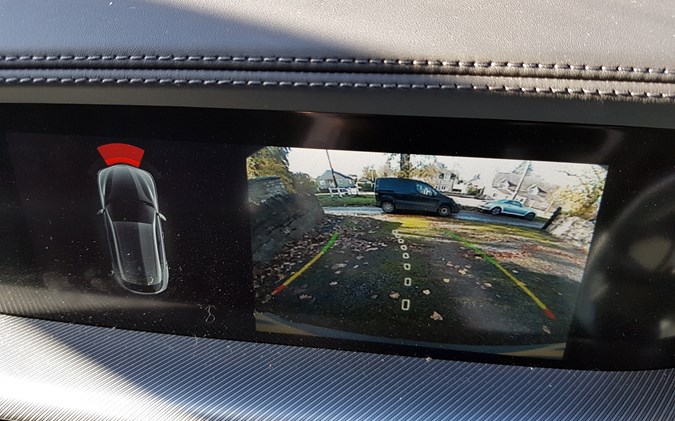
The infotainment system has seen a 2023 welcome upgrade to earlier versions of the Stelvio. The screen though is still only 8.8 inches in size and it doesn’t have that much contrast so can seem a little on the dull side. As mentioned above, the rear-view camera display is somewhat small and a boost in screen size would really help. In our opinion, some of the graphics in the Tom-Tom powered nav are a bit retro to say the least. The Navigation mapping graphics and fonts would certainly benefit from an overhaul to give them a much more modern feel.
The capacitive touch-screen gave us no issues and putting in a variety of destinations in navigation always got us to our destination without any fuss.
We hooked up both an Android and iPhone to check over the Android Auto and Apple CarPlay functionality. These are both fitted as standard and worked as expected. The only downside is there’s no wireless connectivity.
Update 5: ‘The Pasty Run’
It’s getting late in the year, but I needed to make a trip down to the South-West. The trip would take me within a few miles of Land’s End so I’ll take the opportunity on the return trip to grab some pasties from our favourite pasty outlet ‘The Original Looe Bakery’ – of course located in the popular seaside town of Looe. When I mentioned the trip, the office chaps have been frequently reminding me not to forget about the Pasty Run. I’ll be in the dog-house if I do!
Cornwall of course is awash with pasty outlets but they’re not all the same [some are not even that good] – it’s a lottery that’s for sure. We’ve tried many and the guys at ‘The Original Looe Bakery‘ never fail to impress. They come out on top notch in our opinion on a regular basis so I’ll make sure we have a fresh batch of 10 loaded up before the sprint back to Peterborough.

As mentioned in the first driving impressions, the Stelvio certainly feels very much at home on the open road. Whether the road is a bumpy back road or a smooth free-flowing ‘A’ road, this is a car that wants to be driven and even a change of road surface doesn’t distract with the car feeling equally at happy on either.
I left Peterborough on a Tuesday and headed off down on the A1. The route I’m taking is slightly different as I prefer a change of scenery from time to time. Also, the tedious A14/M6/M42/M5 route gets rather boring after a while. Also, I wanted to see how the car performs on roads that are not quite up to motorway standards.
With this in mind, I took the A1 South and then the A421 across to Bedford and cross country out towards Buckingham. From here, we continue out towards Chipping Norton, Stow, Cirencester then joining the M5 at Bristol. OK it’s not the fastest route, but it involves a good amount of twisty ‘A’ roads and a various mixture of driving scenarios. Some parts are quick, others not so and there’s a fair amount of traffic from time-to-time.
At Bristol, I took the M5 for a fast sprint to Exeter giving the Stelvio the opportunity to stretch its legs. It doesn’t fail to deliver either and we cover the run to Exeter in just under an hour cruising at the maximum legal limit. From Exeter it’s time for the car to put in a little more extra effort as we tackle some of the undulating hills around the perimeter of Dartmoor running effortlessly down the A30 through Oakhampton, Launceston and Bodmin and finally down to Penzance ready for an overnight stay.

On open main trunk roads, the car shows its calibre with the 280 horses quickly obeying the command to pick up the pace when required. Inclines in the road are swiftly swept by and the miles are covered with ease and without any fuss. Fast cornering is one of the cars highlighted plus points. Very little input is required and the car stays settled even at high speed around quite sharp and twisty roads.
One thing that should be mentioned is that you cover the miles with so much ease and with very little fatigue. We’ve frequently mentioned in the Parkers reviews about the ‘numb-bum’ scenario that can [and does] affect some cars – leaving your backside feeling that it’s been detached from the rest of your body, even after an hour or so of driving.
We’re happy to report that the super-comfy Stelvio bucks the trend here and even after the slower initial cross-country run from Peterborough to Bristol which took about 4 hours, I felt in pretty good shape. Although a stretch of the legs was very welcome, I felt very comfortable in the cabin and pretty fresh.
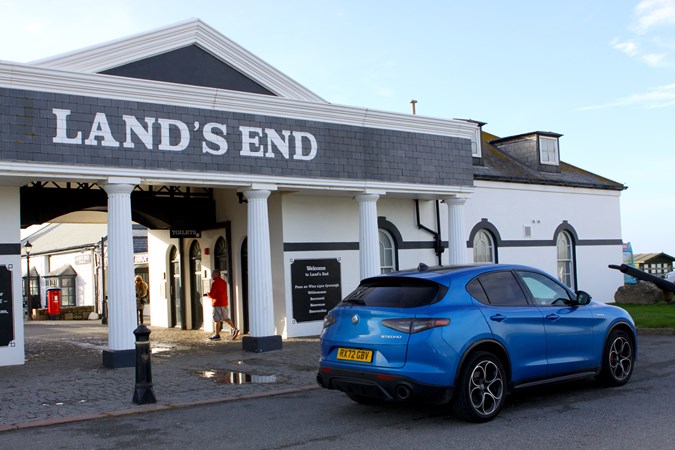
Having arrived in Penzance not too late in the afternoon, I decided to nip the extra 10 miles or so down the A30 to Land’s End and of course it was time for the obligatory souvenir photo or two.
Some of the regular Parkers readers may remember that back in 2017 I took Suzuki’s little ‘Ignis’ city car from Land’s End to John O’Groats on just £60 worth of fuel.
Whilst I’ve no plans to take the Stelvio North of the border during this extended loan, I decided that on the return run, a brisk sprint on the A30/A303 would be in order, joining the A34 just to the East of Andover and then M40/A43/A45 back home.
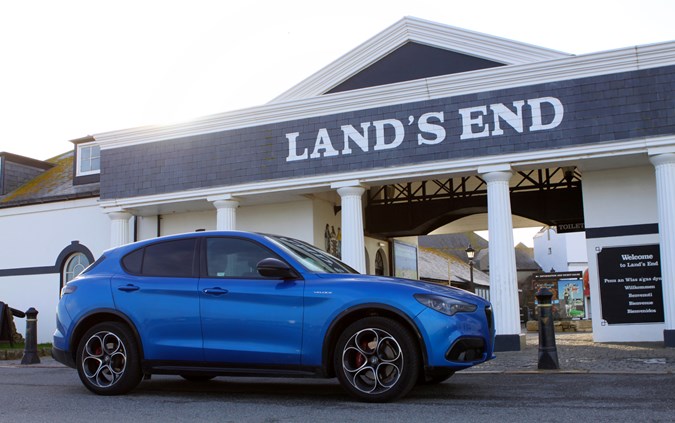
All was going well until I reached Wincanton on the A303 when the navigation system seemed to get a bit hot under the collar. A warning message appeared and said that ‘Audio’ alerts would cease as the unit was running hot. This initially took me by surprise as it wasn’t a warm day outside [only 14 degrees] and the unit had never complained in the past. When we collected the car in mid-summer, we had temperatures of around 29 degrees and this error had never materialised prior or in those conditions.
Pulling into a service area, I rested up for about an hour and following start-up, the error never came back. I put it down to ‘just one of those software related things’ and since then the error has never shown its face.

Update 6: Getting your hands on one and round-up
Well, we never ever got bored of our long-term Stelvio. It was great to be at the helm of a car that wanted to be driven. Out on the open road it excelled frequently with a powerful responsive upbeat drive. In the cabin, the front seats were super comfortable. I’ll be sorry to see it go.
There’s certainly plenty to like about the Stelvio. When driven at under 65mph, the car can actually be quite frugal. But at around 70mph then the fuel consumption tends to drop and quite rapidly. Above this then she likes a ‘drink’ and unleash all those horses and you’ll be filling up more often than not.
For prospective owners, we’ve asked our trade partners at CAP/HPi to look at the ‘Future Residual Values’ [FRV’s] of a brand new Stelvio Petrol 280hp Veloce car purchased in February 2024. The car is base spec with no options and the figures below show the car at various ages and mileages. Click for a larger version.
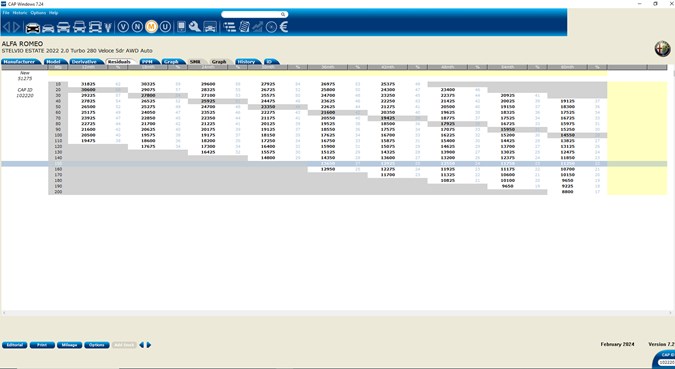
As an example, the car new today will have a retail value of £52,620 and the same car in 12 months’ time [if it’s covered 10,000 miles] will have an FRV of £31,825. This equates to a 62% FRV. The same car in 3 years’ time based on covering 30,000 miles will have an estimated FRV of £24,700 [48% FRV].
Eagle eyed buyers will know that a car loses most of its money during the first three years of ownership. Potential buyers of a second-hand example may want to look towards a car of around 3-4 years in age. A current 2020/20 plate Veloce 280 petrol with 30,000 miles and options of 20-inch wheels and metallic paint will have a current value of around £28,360 [private] and up to £30,400 at a dealership.

Buying a new car? – well you have quite a few options.
You can purchase one directly through Alfa Romeo’s UK website. The interface is great to use and is very intuitive. You get the frills of buying through the official UK dealer network and you’ll get all main/franchised dealer services and backup support at hand as well. Start your buying journey here.
Buy from independent outlets such as ‘Heycar’ or ‘Nationwide Cars’
Heycar and Nationwide Cars are leading independent car outlets, both with great reputations. You’ll often see new cars at discounted prices and you may find a very low mileage late example with big discounts. Check out their sites here.
SUMMING THINGS UP:
What we liked
- Standard amount of kit is impressive
- Front seats are super comfy
- Fuel consumption can be impressive for a performance car
- Handling is great for an SUV – it’s a real driver’s car
- For a big car it’s quick – 62mph in 5.5 seconds
- Bags of room in the boot for the weekly shop
What didn’t quite hit the mark
- The Nav and infotainment screen is rather dated and retro
- We’d like to see a new bigger nav screen with modern graphics and fonts
- Comfort in the rear could be improved
- Thick side pillars can make some ‘views’ restrictive
Last updated by: Percy Lawman – 26th February 2024



